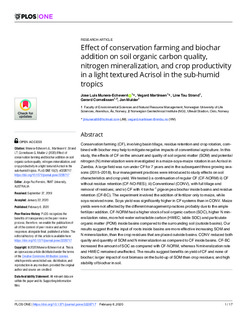| dc.contributor.author | Munera-Echeverri, Jose L | |
| dc.contributor.author | Martinsen, Vegard | |
| dc.contributor.author | Strand, Line Tau | |
| dc.contributor.author | Cornelissen, Gerard | |
| dc.contributor.author | Mulder, Jan | |
| dc.date.accessioned | 2020-02-14T13:18:55Z | |
| dc.date.available | 2020-02-14T13:18:55Z | |
| dc.date.created | 2020-02-09T19:09:29Z | |
| dc.date.issued | 2020 | |
| dc.identifier.citation | PLOS ONE. 2020, 15 (2), . | |
| dc.identifier.issn | 1932-6203 | |
| dc.identifier.uri | http://hdl.handle.net/11250/2641786 | |
| dc.description.abstract | Conservation farming (CF), involving basin tillage, residue retention and crop rotation, combined with biochar may help to mitigate negative impacts of conventional agriculture. In this study, the effects of CF on the amount and quality of soil organic matter (SOM) and potential nitrogen (N) mineralization were investigated in a maize-soya-maize rotation in an Acrisol in Zambia. A large field was run under CF for 7 years and in the subsequent three growing seasons (2015–2018), four management practices were introduced to study effects on soil characteristics and crop yield. We tested i) a continuation of regular CF (CF-NORM) ii) CF without residue retention (CF-NO-RES); iii) Conventional (CONV), with full tillage and removal of residues; and iv) CF with 4 ton ha-1 pigeon pea biochar inside basins and residue retention (CF-BC). The experiment involved the addition of fertilizer only to maize, while soya received none. Soya yield was significantly higher in CF systems than in CONV. Maize yields were not affected by the different management practices probably due to the ample fertilizer addition. CF-NORM had a higher stock of soil organic carbon (SOC), higher N mineralization rates, more hot-water extractable carbon (HWEC; labile SOC) and particulate organic matter (POM) inside basins compared to the surrounding soil (outside basins). Our results suggest that the input of roots inside basins are more effective increasing SOM and N mineralization, than the crop residues that are placed outside basins. CONV reduced both quality and quantity of SOM and N mineralization as compared to CF inside basins. CF-BC increased the amount of SOC as compared with CF-NORM, whereas N mineralization rate and HWEC remained unaffected. The results suggest benefits on yield of CF and none of biochar; larger impact of root biomass on the build-up of SOM than crop residues; and high stability of biochar in soil. | |
| dc.language.iso | eng | |
| dc.title | Effect of conservation farming and biochar addition on soil organic carbon quality, nitrogen mineralization, and crop productivity in a light textured Acrisol in the sub-humid tropics | |
| dc.type | Peer reviewed | |
| dc.type | Journal article | |
| dc.description.version | publishedVersion | |
| dc.source.pagenumber | 17 | |
| dc.source.volume | 15 | |
| dc.source.journal | PLOS ONE | |
| dc.source.issue | 2 | |
| dc.identifier.doi | 10.1371/journal.pone.0228717 | |
| dc.identifier.cristin | 1792384 | |
| cristin.unitcode | 7452,5,2,0 | |
| cristin.unitname | Forurensning og arealutvikling | |
| cristin.ispublished | true | |
| cristin.fulltext | original | |
| cristin.qualitycode | 1 | |
